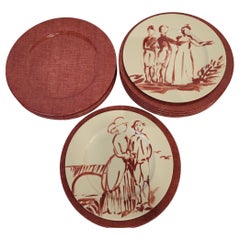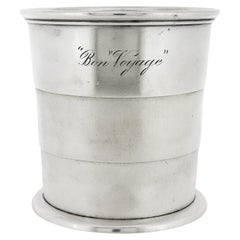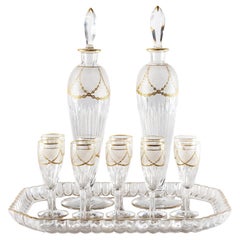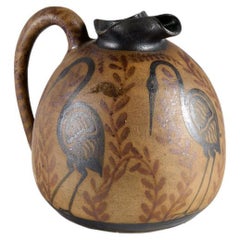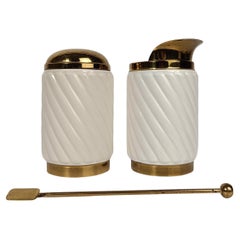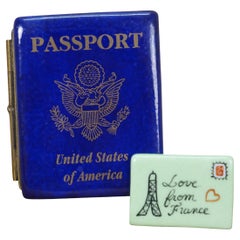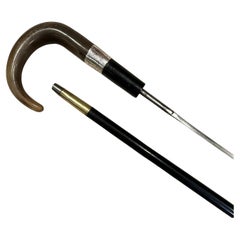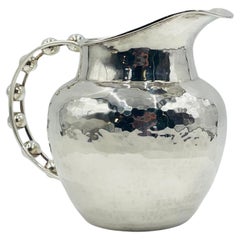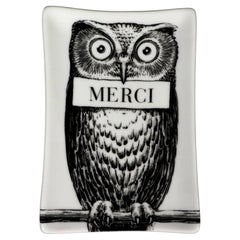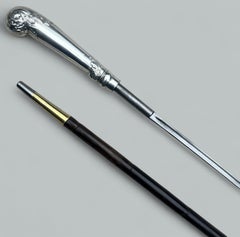Serveware, Ceramics, Silver and Glass
Late 20th Century French Serveware, Ceramics, Silver and Glass
Porcelain
19th Century English Victorian Antique Serveware, Ceramics, Silver and Glass
Sterling Silver, Steel
1980s Mexican Organic Modern Vintage Serveware, Ceramics, Silver and Glass
Silver Plate, Brass
Early 2000s Italian Modern Serveware, Ceramics, Silver and Glass
Ceramic
19th Century English Victorian Antique Serveware, Ceramics, Silver and Glass
Sterling Silver, Steel
1970s Italian Mid-Century Modern Vintage Serveware, Ceramics, Silver and Glass
Metal
20th Century Italian Mid-Century Modern Serveware, Ceramics, Silver and Glass
Metal
Early 20th Century French Renaissance Revival Serveware, Ceramics, Silver and Glass
Metal, Sterling Silver
1960s Mexican Mid-Century Modern Vintage Serveware, Ceramics, Silver and Glass
Silver Plate, Brass
Mid-20th Century Serveware, Ceramics, Silver and Glass
Silver Plate
1980s Mexican Organic Modern Vintage Serveware, Ceramics, Silver and Glass
Lapis Lazuli, Malachite, Silver Plate
21st Century and Contemporary Italian Serveware, Ceramics, Silver and Glass
Murano Glass
1970s Mexican Mid-Century Modern Vintage Serveware, Ceramics, Silver and Glass
Malachite, Silver Plate
1880s French Victorian Antique Serveware, Ceramics, Silver and Glass
Ceramic, Faience, Majolica
Mid-20th Century Italian Mid-Century Modern Serveware, Ceramics, Silver and Glass
Brass
1990s Spanish Post-Modern Serveware, Ceramics, Silver and Glass
Glass, Murano Glass
1960s Italian Mid-Century Modern Vintage Serveware, Ceramics, Silver and Glass
Murano Glass
19th Century French French Provincial Antique Serveware, Ceramics, Silver and Glass
Terracotta
1920s French Art Deco Vintage Serveware, Ceramics, Silver and Glass
Brass
Late 19th Century English Victorian Antique Serveware, Ceramics, Silver and Glass
Sterling Silver
1950s Swedish Scandinavian Modern Vintage Serveware, Ceramics, Silver and Glass
Stoneware
1960s German Vintage Serveware, Ceramics, Silver and Glass
Glass
1980s Canadian Post-Modern Vintage Serveware, Ceramics, Silver and Glass
Ceramic
1960s English Neoclassical Vintage Serveware, Ceramics, Silver and Glass
Porcelain
Mid-20th Century Unknown Country Serveware, Ceramics, Silver and Glass
Oak
Mid-20th Century French Mid-Century Modern Serveware, Ceramics, Silver and Glass
Metal
20th Century Dutch Serveware, Ceramics, Silver and Glass
Silver
1870s Antique Serveware, Ceramics, Silver and Glass
Majolica
Mid-18th Century German Biedermeier Antique Serveware, Ceramics, Silver and Glass
Brass, Copper
Early 1900s German Art Nouveau Antique Serveware, Ceramics, Silver and Glass
Stone, Silver
1960s French Mid-Century Modern Vintage Serveware, Ceramics, Silver and Glass
Bronze, Brass
2010s American Organic Modern Serveware, Ceramics, Silver and Glass
Ceramic
1880s French Victorian Antique Serveware, Ceramics, Silver and Glass
Ceramic, Faience, Majolica
Mid-20th Century Italian Mid-Century Modern Serveware, Ceramics, Silver and Glass
Art Glass, Blown Glass, Murano Glass
Mid-20th Century Italian Serveware, Ceramics, Silver and Glass
Metal
Mid-20th Century Swedish Scandinavian Modern Serveware, Ceramics, Silver and Glass
Ceramic, Stoneware
2010s Argentine Organic Modern Serveware, Ceramics, Silver and Glass
Stone, Onyx, Metal
1990s French Serveware, Ceramics, Silver and Glass
Crystal
Late 19th Century American Victorian Antique Serveware, Ceramics, Silver and Glass
Sterling Silver
1890s Czech Art Nouveau Antique Serveware, Ceramics, Silver and Glass
Blown Glass
1940s French Art Deco Vintage Serveware, Ceramics, Silver and Glass
Ceramic
1920s Austrian Art Deco Vintage Serveware, Ceramics, Silver and Glass
Brass
1960s Danish Mid-Century Modern Vintage Serveware, Ceramics, Silver and Glass
Ceramic, Rattan
Mid-20th Century American Mid-Century Modern Serveware, Ceramics, Silver and Glass
Glass
2010s South American Modern Serveware, Ceramics, Silver and Glass
Stone, Onyx, Metal
1870s French Napoleon III Antique Serveware, Ceramics, Silver and Glass
Crystal
Mid-20th Century Italian Mid-Century Modern Serveware, Ceramics, Silver and Glass
Art Glass, Cut Glass, Murano Glass, Sommerso, Glass
1960s Italian Modern Vintage Serveware, Ceramics, Silver and Glass
Gold, Gold Leaf
Mid-20th Century Austrian Mid-Century Modern Serveware, Ceramics, Silver and Glass
Metal, Zinc
1990s Swedish Scandinavian Modern Serveware, Ceramics, Silver and Glass
Art Glass
2010s South American Modern Serveware, Ceramics, Silver and Glass
Stone, Onyx, Metal
Early 1900s German Art Nouveau Antique Serveware, Ceramics, Silver and Glass
Enamel
1970s Italian Modern Vintage Serveware, Ceramics, Silver and Glass
Crystal
20th Century Modern Serveware, Ceramics, Silver and Glass
Sterling Silver
2010s American Modern Serveware, Ceramics, Silver and Glass
Ceramic, Porcelain
Mid-18th Century Rococo Antique Serveware, Ceramics, Silver and Glass
Pewter
Early 19th Century English Country Antique Serveware, Ceramics, Silver and Glass
Pottery
21st Century and Contemporary Peruvian Serveware, Ceramics, Silver and Glass
Stone
1950s American Mid-Century Modern Vintage Serveware, Ceramics, Silver and Glass
Glass
Mid-20th Century Japanese Meiji Serveware, Ceramics, Silver and Glass
Porcelain
Antique and Vintage Serveware, Ceramics, Silver and Glass
Your dining room table is a place where stories are shared and personalities shine — why not treat yourself and your guests to the finest antique and vintage glass, silver, ceramics and serveware for your meals?
Just like the people who sit around your table, your serveware has its own stories and will help you create new memories with your friends and loved ones. From ceramic pottery to glass vases, set your table with serving pieces that add even more personality, color and texture to your dining experience.
Invite serveware from around the world to join your table settings. For special occasions, dress up your plates with a striking Imari charger from 19th-century Japan or incorporate Richard Ginori’s Italian porcelain plates into your dining experience. Celebrate the English ritual of afternoon tea with a Japanese tea set and an antique Victorian kettle. No matter how big or small your dining area is, there is room for the stories of many cultures and varied histories, and there are plenty of ways to add pizzazz to your meals.
Add different textures and colors to your table with dinner plates and pitchers of ceramic and silver or a porcelain lidded tureen, a serving dish with side handles that is often used for soups. Although porcelain and ceramic are both made in a kiln, porcelain is made with more refined clay and is more durable than ceramic because it is denser. The latter is ideal for statement pieces — your tall mid-century modern ceramic vase is a guaranteed conversation starter. And while your earthenware or stoneware is maybe better suited to everyday lunches as opposed to the fine bone china you’ve reserved for a holiday meal, handcrafted studio pottery coffee mugs can still be a rich expression of your personal style.
“My motto is ‘Have fun with it,’” says author and celebrated hostess Stephanie Booth Shafran. “It’s yin and yang, high and low, Crate & Barrel with Christofle silver. I like to mix it up — sometimes in the dining room, sometimes on the kitchen banquette, sometimes in the loggia. It transports your guests and makes them feel more comfortable and relaxed.”
Introduce elegance at supper with silver, such as a platter from celebrated Massachusetts silversmith manufacturer Reed and Barton or a regal copper-finish flatware set designed by International Silver Company, another New England company that was incorporated in Meriden, Connecticut, in 1898. By then, Meriden had already earned the nickname “Silver City” for its position as a major hub of silver manufacturing.
At the bar, try a vintage wine cooler to keep bottles cool before serving or an Art Deco decanter and whiskey set for after-dinner drinks — there are many possibilities and no wrong answers for tableware, barware and serveware. Explore an expansive collection of antique and vintage glass, ceramics, silver and serveware today on 1stDibs.
Read More
How a Craving for Color Revolutionized Glass
After synthetic dyes changed fashion, home goods and printed matter, it was only a matter of time till glass caught up.
1882 Ltd. Looks to the Future of Ceramics in the U.K. with an Eclectic Exhibition and Auction
Faye Toogood and John Pawson are among the list of plate designers.
20 Inviting Dining Rooms Perfectly Arranged for Entertaining
Top interior designers show — and tell — us how to create delectable spaces for hosting dinner parties.
Paul Revere Crafted This Silver Coffee Pot 250 Years Ago
Perhaps best known as a Revolutionary War hero, Revere was also an accomplished silversmith, and this pot is now available on 1stDibs.
From Arne Jacobsen to Zaha Hadid, Top Designers Tackle Tableware
Clever objects like these make feasting even more festive.
How the Chunky, Funky Ceramics of 5 Mid-Century American Artists Balanced Out Slick Modernism
Get to know the innovators behind the pottery countercultural revolution.
Ready for a Cinderella Moment? This Glass Handbag Is a Perfect Fit
Glass slippers might be the stuff of fairytales, but glass handbags? Artist Joshua Raiffe has made them a reality, and they're far less delicate than you might imagine, but just as dreamy.
With Dansk, Jens Quistgaard Delivered Danish Simplicity to American Tables
When a visionary Copenhagen designer teamed up with an enterprising Long Island couple, Scandi-style magic landed in kitchens and dining rooms across the United States.
